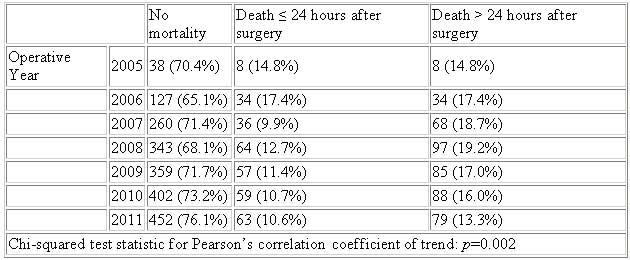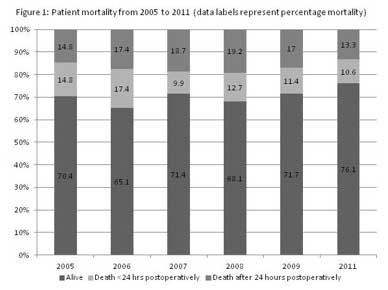Back to 2015 Annual Meeting Abstracts
Improved Trends in Patient Survival and Decreased Major Complications after Emergency Ruptured Abdominal Aortic Aneurysm Repair from 2005 to 2011
Reshma Brahmbhatt, Jennifer Gander, Sebastian Perez, Luke Brewster, Yazan Duwayri, Ravi Rajani, Susan Shafii, Ravi Veeraswamy, Atef Salam, Shipra Arya
Emory University, Atlanta, GA
INTRODUCTION:
Emergency abdominal aortic aneurysm (AAA) repair carries a high risk of morbidity and mortality. This study seeks to examine morbidity and mortality trends from the National Surgical Quality Improvement Program (NSQIP) database, and identify potential risk factors.
METHODS:
All emergency AAA repairs were identified using the NSQIP database from 2005-2011. Univariate analysis (using Studentís t-test, Chi-squared, and Fisherís exact test) and multivariate logistic regression was performed to examine trends in mortality and morbidity.
RESULTS:
Out of 2761 patients who underwent emergency AAA repair, 321 (11.6%) died within 24 hours of surgery. Of the remaining 2440 patients, 1133 (46.4%) had major complications and 459 (18.8%) died during the postoperative period. From 2005 to 2011, there was a significant decrease in patient mortality, particularly in patients who survived the perioperative period (p=0.002, Table 1). Total complications increased overall (p<0.0001); however, major complications decreased from 58.7% in 2005 to 42.6% in 2011 (p<0.0001) in the patients who survived beyond 24 hours. The use of endovascular repair increased over the study period (p<0.0001). On multivariate analysis of patients who survived past the initial 24-hour period, age (odds ratio [OR] 1.050), open repair (OR 1.8), and presence of a major complication (OR 3.3) were significantly associated with death (p<0.001).
CONCLUSIONS:
Patient survival has increased from 2005 to 2011 after emergency AAA repair, with a significant improvement particularly in patients who survive past the first 24 hours. Though total complications increased, major complications decreased over the study period, suggesting newer techniques and patient care protocols may be improving outcomes.
Table 1: Patient mortality from 2005 to 2011


Back to 2015 Annual Meeting Abstracts
